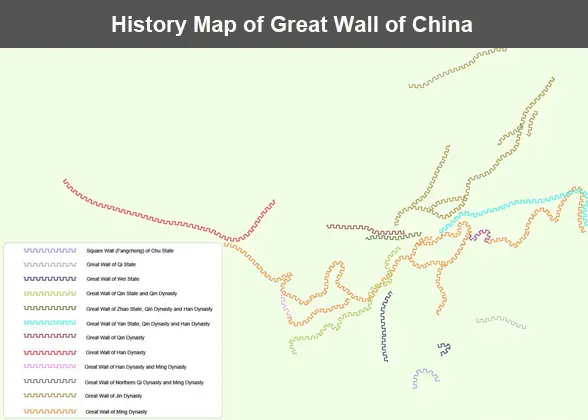The history of the Great Wall is said to have started from the Spring and Autumn Period (770 - 476 BC). Over the following 2,500 years, more than 20 states and dynasties played a part in its construction. The accumulative length of the wall exceeds 21,196.18 km (13,170.70 mi).
In the turbulent Zhou Dynasty that consisted of Western Zhou Dynasty (1046BC-771BC), Spring and Autumn Period, and Warring States Period (475BC-221BC), several contemporary powerful states were established. In order to defend themselves, they all built walls and stationed troops on their borders. The earliest of these is the
Chu State Great Wall, also known as "Square Wall". Later, other states added to the construction, including
Qi State, Wei State,
Yan State,
Zhao State, and
Qin State. The sections built by different states were unconnected until the reign of
Emperor Qin Shi Huang.
In 221BC, Emperor Qin Shi Huang unified China for the first time after defeating the other states. As the central plain was constantly assaulted by the northern Huns, Emperor Qin Shi Huang sent the great general Meng Tian to fight back. At the same time, he ordered that the sections of the Great Wall created by different states be linked together and extended. Thereafter, the Great Wall, which runs eastward from Lintao (today's Minxian County in Gansu Province) to Yalu River in Liaoning Province, flew over mountain ridges, rivers, deserts, and plains in north China like a giant dragon.
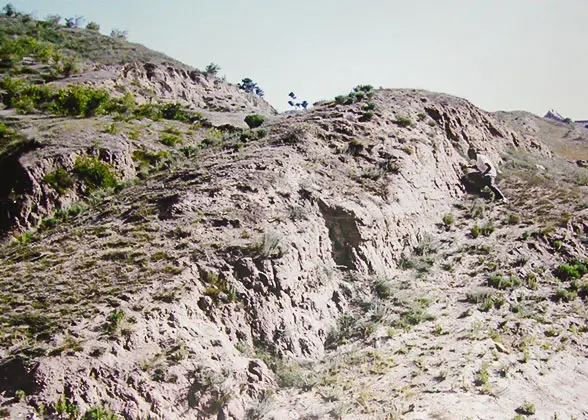 | Wall of
Warring States Period | | 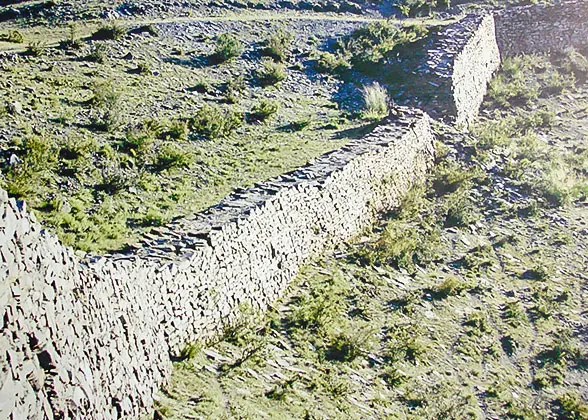 | Qin Dynasty wall on Yinshan
Mountain, Guyang County, Inner Mongolia | |
After Emperor Qin Shi Huang's death, the Qin Dynasty soon came to an end due to mass uprisings. Han Dynasty was then established by Emperor Gaozu, who had the previous wall renovated and reinforced. Later, Emperor Wu of Han constructed the Great Wall in a large scale. He had Yanmenguan Pass restored in 130BC, and the Qin Dynasty Wall renovated in 127BC. In order to protect the Hexi Corridor, he ordered the defensive line between Yongdeng County and Jiuquan in Gansu Province be built in 121BC. The line was extended from Jiuquan to Yumenguan Pass from 111BC to 110BC, and it was further lengthened to Lop Nor in Xinjiang from 104BC to 101BC. The Han Dynasty Wall was not only a defense against northern Huns, but it also protected the ancient Silk Road linking China and the western regions.
As the central court maintained affiliation with the northern tribes, there was not massive construction of the Great Wall during the Jin Dynasty, but mainly the renovation work of the eastern segment of the Qin Dynasty wall.
After the decline of the unified Han Dynasty, China endured a period of chaos when different states vied with one another as they sought to expand their territories. In turn, they each added to the Great Wall to defend themselves. The Northern Wei, Northern Qi, Eastern Wei, and Northern Zhou Dynasties all built their own sections, but on a smaller scale than the Han Dynasty.
The establishment of Sui Dynasty put an end to the tumultuous period. The successive emperors attached great importance to border defense on account of the constant invasion by northern nomadic tribes. They ordered the wall and fortresses be built in the north and west. It took two million laborers 28 years to finish the large project. Thereafter, the defensive system stretched from Zihe River (an ancient river in today's south Inner Mongolia and northwest Shanxi) in the east, via Lingwu of Ningxia, and ended at Yugu (today's Guide County of Qinghai Province) in the west.
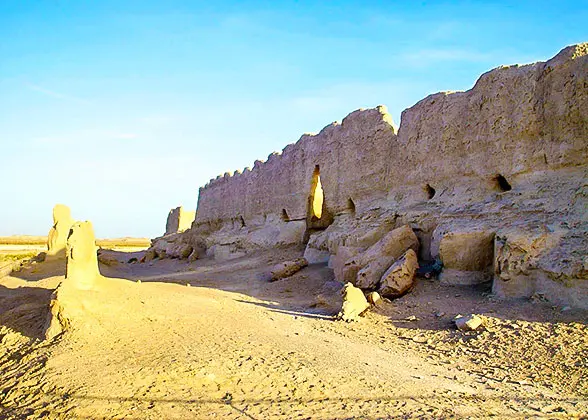 | Han Dynasty wall,
Dunhuang, Gansu | | 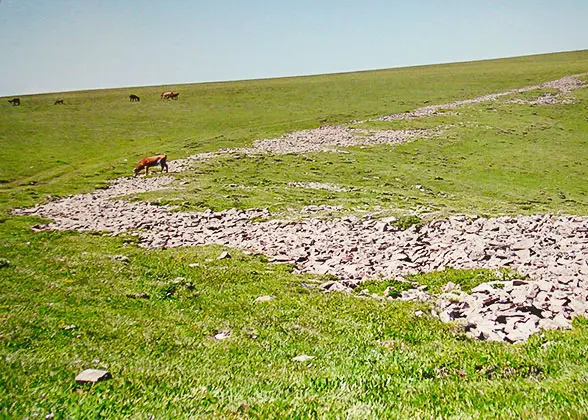 | Great Wall of Northern Dynasties
to Sui Dynasty in Ningwu County, Shanxi | |
The subsequent Tang Dynasty brought an era of comparative peace between the northern tribes and central China for most of the time, so few sections were built during this period.
The massive construction work of the Great Wall was implemented along the boundary line with the Bohai Kingdom while Emperor Shengzong (972 - 1031) and Xingzong (1016 - 1055) were in power. The Wall is also called Liao Bianhao with one single wall and a trench on the outside.
The history of Great Wall continued during the Song Dynasty to defend against the invaders from the north and west, like Western Xia, Liao, and Jin. Nevertheless, the Wall failed to stop the intrusion of northern Jin Dynasty, leading to demise of Song Dynasty in 1127. Fortunately, Zhao Gou, known as Emperor Gaozu of Song, escaped to southern China and reestablished the Song in Lin'an (today's Hangzhou), historically called Southern Song Dynasty and the previous Song was named Northern Song Dynasty to distinguish between them. Owing to a lack of money and confidence in the natural barriers like Yangtze River and many other crisscrossing rivers, the Southern Song did not build the defensive line on its territory.
After defeating the Northern Song, the Jin Dynasty became a strong regime in northeast China. However, threatened by neighboring states, like Western Xia, and Mongol Empire, the Jin Dynasty began to build the northernmost wall of China in 1194, but the project was suspended due to drought and the objection of ministers. In 1196, the project was started again, and lasted three years. The Jin Dynasty Wall has a total length of about 1,025 miles (1,650 kilometers). There were also ditches, beacon towers, fortresses, and garrisons along the wall.
Yuan Dynasty (1271 - 1368)
The strong Mongol Empire on horseback absorbed Western Xia, Jin, Southern Song as well as some other states, established the unified Yuan Dynasty. Owing to its large territory and strong military power, few sections were built during the Yuan Dynasty.
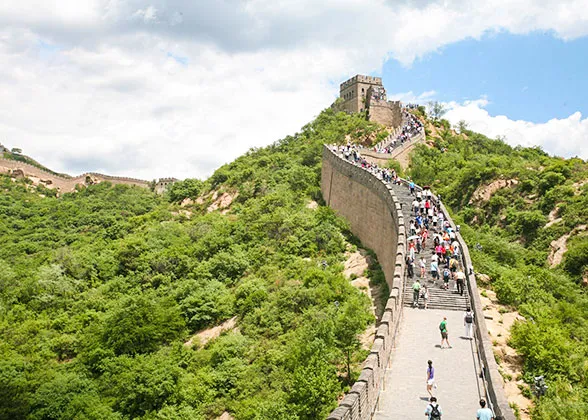 |
Badaling section of
Ming Dynasty, Beijing |
By contrast, the subsequent Ming Dynasty became the peak of Great Wall's history. From its establishment, the Ming Dynasty was harassed by northern tribes, like Tartars and Jurchens. Consequently, it continued the construction of the defensive line throughout its rule of over two centuries. Besides adding many more miles of its own, the Ming emperors ordered enlargement of the walls of previous dynasties into double-line or multi-line walls. For example, out of Yanmenguan Pass were added three big stone walls and 23 small ones. The main line of the Ming Dynasty started from
Hushan near the Yalu River in the east to the
Jiayuguan Pass in the west. It has a total length of about 5,500 miles (8,851.8 kilometers).
The Ming Dynasty Wall was solid, but it failed to stop the cavalries of the Qing Dynasty, a regime established by Manchu people in northeast China. The Qing cavalries broke through
Shanhaiguan Pass, and occupied the central plain. In the early Qing Dynasty, the emperors thought they were strong enough to defend themselves; very few additions to the wall were built. Later, in order to prevent Han people from entering northeast China and Inner Mongolia, they ordered a deep trench be dug in Liaoning and Inner Mongolia, and the willows be planted along the trench. Hence, the Qing Dynasty Wall was also called "Willow Line".
Massive construction work of Great Wall was not implemented during this period and this former defensive facility welcomed a nationwide renovation since 1980s. Nowadays, it has become the national symbol and one of the most popular tourist destinations in China.
In time, the Great Wall gradually ceased to function as a military defensive system and many sections are severely damaged or disappearing due to natural disasters and human activity. However, it is a precious heritage of all mankind and witness to Chinese history that deserves better preservation and protection.
 Further Reading:
Further Reading:
Great Wall Chronology
Top 8 Great Wall of China Events in History
How old is Great Wall of China?
Which Dynasties didn't Build the Great Wall
Fun Facts about Great Wall: 25 Things You didn't Know
History of China
- Last updated on Jan. 08, 2024 by Brenda Lian -

![]() Further Reading:
Further Reading: